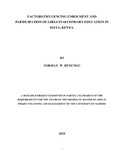| dc.description.abstract | This research project sought to investigate the factors influencing the enrolment and
participation of girls in secondary education. Education for a girl, in particular, post primary
education, has important individual benefits in terms of her options and resources over her life
time. The benefits to society include enhanced economic development, education for the next
generation, healthier families and fewer maternal deaths. These benefits extend beyond the girl
to affect her family and the society as a whole. Of more than 110 million children not in school,
approximately 60 percent are girls. By the age of 18, girls will have received an average of 4.4
less education than boys. This is the present picture of girls throughout the globe.
The researcher hoped to use the findings of the study to contribute to the concerted effort
to improve the enrolment and participation of girls in secondary education and to provide the
necessary facts needed by the ministry of education for proper planning to improve girls‟
education. The study was guided by the following objectives: Establish how the school
environment influences the participation of girls in secondary education, determine the
individual challenges that affect the enrolment and participation of girls in secondary education
and Find out the contribution of the community towards the enrolment and participation of girls
in secondary education.
The study adopted a descriptive survey design with both qualitative and quantitative
approaches. Data collection was conducted using two instruments; that is the interview schedules
and questionnaires. The quantitative data was analyzed using the Statistical package for social
sciences(SPSS), While the qualitative data was analyzed in three basic steps. First, data was
organized in thematic areas in line with the objectives. Secondly, data was summarized into daily
briefs then the briefs were described and expanded to incorporate additional insights from the
observations made in the field. | en_US |

